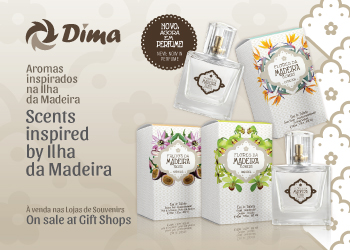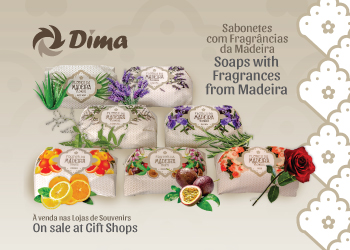The gin trend has arrived in Portugal and Madeira is no exception. The number of bars serving this drink is rapidly increasing and the offer more brands and mixers to it.

In more and more Funchal bars, there they are: balloon glasses, filled with a clear liquid, ice and a slice of lemon or lime, raspberries or even some coffee beans to add even more appeal to the mix.
From being a beverage that few used to drink – only a few loyal gin & tonic lovers remained, largely because of the way it was served in bars here in Portugal –, gin has exploded onto the scene: gin bars everywhere, more and more gin-based cocktails, five gins launched in the space of a year, the first National Gin & Tonic Day in Portugal in June 2013 and even the launch of a magazine, Zest, an initiative by the Gin Lovers group that's described as “the first magazine in the world exclusively dedicated to gin”. Gin's comeback in Portugal can be linked to a phenomenon that has also been witnessed in England, which saw the drink “move from golf club to nightclub”, as described by Geraldine Coates, author of the book The Mixellany Guide to Gin, and conquer a much younger clientele, thirsty for the glamour and sophistication associated to gin thanks to television series such as Mad Men. On the other hand, bars like Oasis, at the 5-star Vila Vita Parc resort in Porches, never really lost that tradition.
Those who have had the pleasure of meeting the head bartender Joaquim Veras know what an old-fashioned wooden bar and a perfectly prepared gin & tonic can do for the soul, just as the wrong proportions of tonic water and gin, served in a tall glass with a lot of ice, without room for the tonic and with dubious-quality gin, has made many people utter the phrase “I don't like gin”.
Now, gin has re-emerged in all its splendour: served in a wider balloon glass, with enough room for the ideal measures – 5cl of gin to 20cl of tonic – and for all the garnishes that the bartenders (having given in to the drink's versatility) choose to add.
But how did this Dutch creation, whose biggest international consumer is the Philippines – alongside England, the Netherlands and the USA – become fashionable in Portugal? It's our Spanish neighbours' fault, themselves “victims” of a recent boom in the last few years. In fact, according to the first edition of Zest, launched in April, it was a Galician who brought it to Portugal. Luís Carballo is the founder of Taberna Moderna in Lisbon, and also of Lisbonita Gin Bar, which offers a selection of more than 60 gins. “There were eight” on the national market, he told Zest, when he opened his tapas house, where Lisbonita can be found, in 2012.
Gin with a Portuguese soul
Today, there are plenty of bars linked to gin. In the north of the country alone, Miguel Camões is the owner of two – the Gin House in downtown Oporto and the Gin Room in Vila do Conde. He is also the founder of the Plastic Deluxe Club in Póvoa do Varzim, which, despite being a general bar, also features a good gin service, and the partner of drinks distributor Discube. It was the huge success of the Gin House, in late 2012, that prompted Miguel to think about launching his own gin. He contacted the Spanish gin-maker Cristina Codesito and together they launched NAO in December 2013. Despite not being a Portuguese gin – NAO is distilled in England as, according to Miguel, “Portugal didn't have a distillery with the technical facilities” that would allow him to make the gin he wanted –, this is a drink with “Portuguese soul”. This because, despite its London Dry base spirit (the best-known gin in the world), NAO spends a number of months in Port wine barrels. “It's a gin with EE EE smooth golden tones because of the barrels. On the nose, it has some notes of spices, fresh citrus (orange and lemon) and vanilla."
Distributed across the country and about to be exported to Spain, NAO Premium Gin has had good market reception, with Miguel revealing that they may launch another product in 2015. The first batch of 5,000 bottles has already been sold and the second will be launched soon. For those who have already purchased a bottle (the shelf price is €39), here's a tip for the perfect serve – add orange peel and three arabica coffee beans.
As for the gin “trend”, Miguel believes consumption should reach its peak in 2015 and then stabilise to levels similar to what they are now. “I don't believe it will disappear; people treat it like a cult, they even drink it at home.”
Gin in a pressure cooker
António Cuco shares the same opinion. The unemployed Tourism teacher turned gin-maker believes that Angola and Brazil will be the tipple's next markets, largely influenced by the Portuguese. “It's an easy import,” he says. Produced in Reguengos de Monsaraz in the Alentejo, Sharish Gin is the latest Portuguese gin to arrive on the market – it seems the Portuguese have invested in quality, as all the gins launched on the national market are premium. António's is no exception: nine botanicals are used in his gin, seven by distillation and two by post-distillation infusion.
With a Tourism degree and part-owner of a restaurant in Reguengos de Monsaraz, the producer has been a lover of the drink for many years. “It's the only alcoholic beverage I drink,” he notes. With around 40 gins in his restaurant, he took on board the words of a customer who told him he should create his own gin. After a first failed attempt, he did some serious research on the subject.
The result? He ended up making gin in a pressure cooker converted into an alembic still until achieving a recipe – very close to the current one – which was a hit amongst his friends. Besides fresh lemon and orange peel (most recipes incorporate dehydrated peel) from his own farm, Sharish is unique in that it features lemon verbena and the Portuguese Bravo de Esmolfe DOP apple as botanicals. Both ingredients evoke childhood memories for the producer and make this gin “rounder, more pleasant and easier to drink”.
Since the gin was officially launched in April this year, they have already sold around 3,000 bottles, and António has already closed deals to export to Angola and Switzerland. In the Algarve, Sharish is distributed by Garrafeira Soares, with a shelf price ranging between €30 and €37. For the producer, his ultimate objective is to see it win awards and have a drink that “barmen like to serve”, whether it's with orange, lime or lemon, juniper and Indian tonic for a summer serve, or Bravo Esmolfe apple and Fever Tree Mediterranean tonic for the perfect winter serve.
While Sharish was the last Portuguese gin to emerge on the market, Big Boss was the first. Launched officially in August 2013, this is a gin that has almost 30 years of experience. Scorpio, its representative and distributor, may have only been created in 1998, but it has all the registrations and patents from Caves Neto Costa, a company that launched the Commodore gin in 1985.
“We picked up on this trend that came from Spain and decided to launch a gin with tradition but from the new generation,” explains Paulo Pereira, commercial director of Scorpio. And thus Big Boss was born, a gin with four distillations and 11 botanicals, amongst which are juniper, Angelica root and cardamom, and which is “very versatile, allowing for various preparations”. Made near Leiria EE EE and with a shelf price of between €25 and €27, Big Boss can be found in Portugal's main wine shops, as well as in Luxembourg, Switzerland, Belgium, Andorra, Angola, Australia and Brazil. “People are impressed by its versatility; it's a very commercial gin.”
It was this success that prompted the launch of another Scorpio gin in August this year, Big Boss Floral, with 13 botanicals, which follows the same qualities as its predecessor but with more floral notes. “Many people were looking for a floral gin with raspberries and red fruits, and we wanted to meet that demand.”
Gin for all tastes
There's certainly no shortage of innovation on the Portuguese market. A month after Big Boss was introduced, the Iberian Peninsula's first premium organic gin was launched on the market: Templus. Made by the organic distillery Oficina de Espíritos in Évora, this gin is produced from organic cereal firewater and 13 botanicals, with distinct notes of pennyroyal and Hart's pennyroyal, which, according to the owner of the company, João Malheiro, give it “herbal qualities”.
Producing some 2,000 bottles and priced at around €40, distribution is ensured by local distributors, gourmet shops and organic produce shops, but João is currently looking for a national distributor, as well as negotiating the internationalisation of his gin in the Netherlands, France, Belgium, Spain, Angola and Mozambique. Assuring that feedback up until now has been great, the producer recommends Templus be served with a quality neutral tonic water, with lemon peel and mint leaf; orange peel and pomegranate seeds; or simply with two or three green olives. That is another quality that's common to the various Portuguese gins available on the market: they have personality but are versatile, allowing for a great variety of combinations. “This wider range of gins available on the market has helped reach a wider range of clients,” highlights Miguel Camões. Organic, resting in Port wine barrels, with Bravo de Esmolfe apples or lemons from the Vincentine Coast it seems Portuguese gin is here to stay. After all, as António Cuco puts it, “I have never met anyone who doesn't like gin. They might not like all the styles, but there is always one that will suit.
Gin in Madeira
There are a few bars in Madeira that serve gin as their main drink, following the trend that has spread throughout the entire country.
Santa Maria is one of the places that consider serving gin as something that sets hem apart from traditional bars. this space is located in Santa Maria Street and its menu offers 39 different types of gin, with a price for every wallet. Monkey 47, Martin Milner and Ophr are among the top requested ones.
In the sophisticated Reid’s Hotel Cocktail Bar, both guests and visitors can quietly enjoy and the pleasures that gin has to offer. with 9 gins available, the highlight goes to the traditional Hendrick’s, G’Vine and GinMario. The bar has been mixing them with fennel or cucumber peel and juice for a while.
Gin is an ever-trending beverage, becoming more and more popular even among those who wouldn’t consider it their drink of choice. It can be mixed with all sorts of spices, citrics and other fruit types. Besides Santa Maria and Reid’s, places like Barreirinha, with 6 types of gin, Trap, with 29 gin options or 5º Juízo Wine and Gin Bar are also other gin-enjoying options for the Madeira fans.














